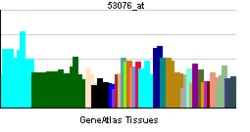B4GALT7
| View/Edit Human | View/Edit Mouse |
Beta-1,4-galactosyltransferase 7 also known as galactosyltransferase I is an enzyme that in humans is encoded by the B4GALT7 gene.[3][3][4][4][5] Galactosyltransferase I catalyzes the synthesis of the glycosaminoglycan-protein linkage in proteoglycans.[6] Proteoglycans in turn are structural components of the extracellular matrix that is found between cells in connective tissues.
Function
Galactosyltransferase I is one of seven β-1,4-galactosyltransferase (β4GalT) enzymes. These enzymes are type II membrane-bound glycoproteins that appear to have exclusive specificity for the donor substrate UDP-galactose; all transfer galactose in a β-1,4 linkage to similar acceptor sugars: GlcNAc, Glc, and Xyl. Each beta4GalT has a distinct function in the biosynthesis of different glycoconjugates and saccharide structures. As type II membrane proteins, they have an N-terminal hydrophobic signal sequence that directs the protein to the Golgi apparatus and which then remains uncleaved to function as a transmembrane anchor. By sequence similarity, the beta4GalTs form four groups: β4GalT1 and β4GalT2, β4GalT3 and β4GalT4, β4GalT5 and β4GalT6, and β4GalT7. The enzyme encoded by this gene attaches the first galactose in the common carbohydrate-protein (GlcA-β-1,3-Gal-β-1,3-Gal-β-1,4-Xyl-beta1-O-Ser) linkage found in proteoglycans. Manganese is required as a cofactor. This enzyme differs from the other six beta4GalTs because it lacks the conserved β4GalT1-β4GalT6 Cys residues and it is located in cis-Golgi instead of trans-Golgi.[5]
Clinical significance
Mutations in the B4GALT7 gene that result in a defective galactosyltransferase I enzyme with reduced or absent activity are associated with progeroid type Ehlers-Danlos syndrome.[4][6][7][8] Since mutations in B4GALT7 impair a glycosylation pathway, the resulting subtype of Ehlers-Danlos syndrome may be considered a congenital disorder of glycosylation (CDG), according to the new CDG nomenclature.
Mutations in B4GALT7 cause Larsen syndrome .Cartault, F; Munier, P; Jacquemont, M. L.; Vellayoudom, J; Doray, B; Payet, C; Randrianaivo, H; Laville, J. M.; Munnich, A; Cormier-Daire, V (2014). "Expanding the clinical spectrum of B4GALT7 deficiency: Homozygous p.R270C mutation with founder effect causes Larsen of Reunion Island syndrome". European Journal of Human Genetics. 23: 49–53. doi:10.1038/ejhg.2014.60. PMID 24755949.
References
- ↑ "Human PubMed Reference:".
- ↑ "Mouse PubMed Reference:".
- 1 2 Okajima T, Yoshida K, Kondo T, Furukawa K (Sep 1999). "Human homolog of Caenorhabditis elegans sqv-3 gene is galactosyltransferase I involved in the biosynthesis of the glycosaminoglycan-protein linkage region of proteoglycans". J Biol Chem. 274 (33): 22915–8. doi:10.1074/jbc.274.33.22915. PMID 10438455.
- 1 2 3 Almeida R, Levery SB, Mandel U, Kresse H, Schwientek T, Bennett EP, Clausen H (Oct 1999). "Cloning and expression of a proteoglycan UDP-galactose:beta-xylose beta1,4-galactosyltransferase I. A seventh member of the human beta4-galactosyltransferase gene family". J Biol Chem. 274 (37): 26165–71. doi:10.1074/jbc.274.37.26165. PMID 10473568.
- 1 2 "Entrez Gene: B4GALT7 xylosylprotein beta 1,4-galactosyltransferase, polypeptide 7 (galactosyltransferase I)".
- 1 2 Okajima T, Fukumoto S, Furukawa K, Urano T (October 1999). "Molecular basis for the progeroid variant of Ehlers-Danlos syndrome. Identification and characterization of two mutations in galactosyltransferase I gene". J. Biol. Chem. 274 (41): 28841–4. doi:10.1074/jbc.274.41.28841. PMID 10506123.
- ↑ Quentin E, Gladen A, Rodén L, Kresse H (Aug 1990). "A genetic defect in the biosynthesis of dermatan sulfate proteoglycan: galactosyltransferase I deficiency in fibroblasts from a patient with a progeroid syndrome.". Proceedings of the National Academy of Sciences of the United States of America. 87 (4): 1342–6. doi:10.1073/pnas.87.4.1342. PMC 53471
 . PMID 2106134.
. PMID 2106134. - ↑ Furukawa K, Okajima T (December 2002). "Galactosyltransferase I is a gene responsible for progeroid variant of Ehlers-Danlos syndrome: molecular cloning and identification of mutations". Biochim. Biophys. Acta. 1573 (3): 377–81. doi:10.1016/S0304-4165(02)00406-3. PMID 12417421.
Further reading
- Amado M, Almeida R, Schwientek T, Clausen H (2000). "Identification and characterization of large galactosyltransferase gene families: galactosyltransferases for all functions". Biochim. Biophys. Acta. 1473 (1): 35–53. doi:10.1016/S0304-4165(99)00168-3. PMID 10580128.
- Seidler DG, Faiyaz-Ul-Haque M, Hansen U, et al. (2007). "Defective glycosylation of decorin and biglycan, altered collagen structure, and abnormal phenotype of the skin fibroblasts of an Ehlers-Danlos syndrome patient carrying the novel Arg270Cys substitution in galactosyltransferase I (beta4GalT-7)". J. Mol. Med. 84 (7): 583–94. doi:10.1007/s00109-006-0046-4. PMID 16583246.
- Gulberti S, Lattard V, Fondeur M, et al. (2005). "Phosphorylation and sulfation of oligosaccharide substrates critically influence the activity of human beta1,4-galactosyltransferase 7 (GalT-I) and beta1,3-glucuronosyltransferase I (GlcAT-I) involved in the biosynthesis of the glycosaminoglycan-protein linkage region of proteoglycans". J. Biol. Chem. 280 (2): 1417–25. doi:10.1074/jbc.M411552200. PMID 15522873.
- Gerhard DS, Wagner L, Feingold EA, et al. (2004). "The Status, Quality, and Expansion of the NIH Full-Length cDNA Project: The Mammalian Gene Collection (MGC)". Genome Res. 14 (10B): 2121–7. doi:10.1101/gr.2596504. PMC 528928
 . PMID 15489334.
. PMID 15489334. - Ota T, Suzuki Y, Nishikawa T, et al. (2004). "Complete sequencing and characterization of 21,243 full-length human cDNAs". Nat. Genet. 36 (1): 40–5. doi:10.1038/ng1285. PMID 14702039.
- Clark HF, Gurney AL, Abaya E, et al. (2003). "The Secreted Protein Discovery Initiative (SPDI), a Large-Scale Effort to Identify Novel Human Secreted and Transmembrane Proteins: A Bioinformatics Assessment". Genome Res. 13 (10): 2265–70. doi:10.1101/gr.1293003. PMC 403697
 . PMID 12975309.
. PMID 12975309. - Strausberg RL, Feingold EA, Grouse LH, et al. (2003). "Generation and initial analysis of more than 15,000 full-length human and mouse cDNA sequences". Proceedings of the National Academy of Sciences of the United States of America. 99 (26): 16899–903. doi:10.1073/pnas.242603899. PMC 139241
 . PMID 12477932.
. PMID 12477932. - Kuroiwa A, Matsuda Y, Okajima T, Furukawa K (2000). "Assignment of human xylosylprotein beta-1,4-galactosyltransferase gene (B4GALT7) to human chromosome 5q35.2→q35.3 by in situ hybridization". Cytogenet. Cell Genet. 89 (1–2): 8–9. doi:10.1159/000015578. PMID 10894925.
- Kresse H, Rosthøj S, Quentin E, et al. (1987). "Glycosaminoglycan-free small proteoglycan core protein is secreted by fibroblasts from a patient with a syndrome resembling progeroid". American Journal of Human Genetics. 41 (3): 436–53. PMC 1684193
 . PMID 3631078.
. PMID 3631078.

